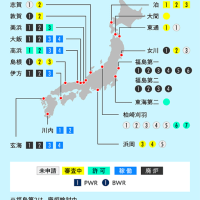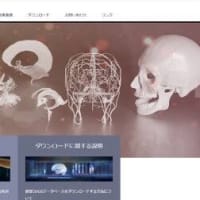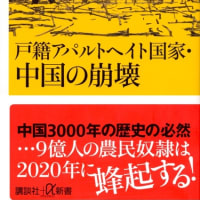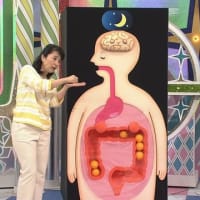06/27/2012 Yomiuri Shimbun . Jiji Press . Chunichi Shimbun . TBS News. Assistant professor of the Kyoto University nuclear reactor experiment place Hiroaki Koide.
http://www.tepco.co.jp/nu/fukushima-np/images/handouts_120627_02-j.pdf
The greatest ever dose measurement (20:37 on June 27, 2012 Yomiuri Shimbun) Tokyo Electric Power announced on the 27th that it measured the 10,300-mm/h sievert used as the greatest ever dose of radiation in the building in No. 1 of the Fukushima first, and a building in the reactor building underground of the first nuclear power plant of No. 1 of Fukushima.
The 50-mm sievert which is a worker's annual contamination contamination limit is become in only about 20 seconds, and acute condition, such as vomiting , appears in about 6 minutes.
Towards decommissioning, although a disclosure place needs specification and restoring by contaminated water in building underground, Toden says, "It becomes the difficult work using not the level that a worker puts in but a robot."
Measurement puts in and carries out an endoscope and a dosimeter from the penetration mouth which is the first floor along which piping passes.
Although there was "pressure control room" of the container lower part in an underground story, damage was not able to be checked with a camera.
The depth of contaminated water was about 5 meters, and the dose went up to about 30 times as many 625-mm/h sieverts by the stage included in an underground story, and recorded the highest near the water surface of contaminated water.
It becomes a dose of 10 times or more of the building underground story of No. 2 or 3.
Toden analyzes it as "No. 1 had the most serious reactor core damage, and many [ underground ] radioactive materials flowed in."
http://www.yomiuri.co.jp/science/news/20120627-OYT1T01115.htm
It is No. 1 and is dosimeter Toden Jiji Press (2012/06/27-21:17) to a 10,000-mm sievert = reactor building.
The Tokyo Electric Power put the dosimeter etc. into the 1st nuclear power plant reactor building underground of No. 1 of Fukushima, and as a result of carrying out an internal investigation, it announced on the 27th that it recorded the 10,300-mm sievert per a maximum of hour.
With the value sharply higher than No. 2 and No. 3, the company is analyzing it as "Since not less than 90% of fuel melted into the container bottom and No. 1 has fallen on it, I think that there is much quantity of a radioactive material."
According to Toden, investigation will be conducted on the 26th.
The camera and thermometer of the endoscope for industry, and the dosimeter were inserted in the "Taurus room" which has stored the pressure control room which collects water by a part of container from the outside.
Variation of the dose was large, and the lowest dose was the Taurus indoor upper part, and was the 19.5-mm sievert.
There was contaminated water in inside from a bottom to a height of about 5 meters, and it was the highest dose near the water surface.
http://www.jiji.com/jc/c?g=soc_30&k=2012062701020
It is the Fukushima building underground of No. 1, and will be at 10,300-mm sievert (Chunichi Shimbun) 20:55 on June 27, 2012.
It was announced on the 27th that the Tokyo Electric Power measured the dose of radiation of a 10,300-mm/h sievert at the maximum in the reactor building underground of the 1st nuclear power plant of No. 1 of Fukushima.
The very high numerical value which will die in about 40 minutes if people are exposed.
The maximum dose measured within the nuclear power plant when removing the inside of the container.
Toden put in the endoscope, the dosimeter, and the thermometer from the crevice between piping of the first floor of the reactor building on the 26th, and investigated the situation of building underground with a pressure control room.
the position which showed the highest numerical value near the water surface of high concentration contaminated water, and was 5 meters away from contaminated water -- 625mmSv -- it was.
The water temperature of contaminated water is about 32?37 degrees, and since it is comparable as the temperature of the nuclear reactor lower part, the water which cooled the nuclear reactor is expected to flow in without placing time.
http://www.chunichi.co.jp/s/article/2012062790205047.html
It is Photography TBS News i (20:04 [ 27-day ]) about a camera and an inside to the underground of a No. 1 building.
The Tokyo Electric Power put the endoscope camera into the underground of the reactor building of the first nuclear power plant of No. 1 of Fukushima for the first time, and photoed the inside covered with contaminated water.
This is the image which the endoscope camera photoed and signs that piping corrodes or the paint and rust which separated are drifting underwater are reflected.
The white spot which is visible to a screen is a noise by strong radiation.
This place was the first basement level with the pressure control room of a reactor building, contaminated water accumulated about 5 meters and water temperature was 37 degrees from 32 degrees.
Although the surface of the water whose dose of radiation was the highest was 10.3 Sv/h and it was a very high dose which will die if there is man for 1 hour, since the dosimeter broke down on the way, the deep-water portion was not able to be measured.
Although it supposed that the Tokyo Electric Power wants to pinpoint the damaged part of a pressure control room by this investigation, I hear that it was not able to specify with an image.
http://news.tbs.co.jp/newseye/tbs_newseye5066754.html
assistant professor of the Kyoto University nuclear reactor experiment place Hiroaki Koide November 1
Hayako Sakiyama : I will protect -- I will protect child get to know -- in order to live in radiation Koriyama .
10,300 mm sievert =10.3 Sv
Not less than 99% dies from =>6 Sv.
Although pinpointing a disclosure part by a robot, taking that up, and making it water coffin is the work schedule which the Tokyo Electric Power has stood, it is a question very much about the ability to do [ how far ] in the state where there is only a meter which breaks in the stage of measuring a dose.
what to do what or the thing which prevents contamination in an epoch-making robot although I, an amateur, cannot do imagination at all, either -- or work will be impossible unless detoxification of the radioactive material of a miracle is realized.
I regard as an infallible thing that this is beginning to leak to groundwater or the sea.
I am sorry [ ... ].
Hiroaki Koide
06/27/2012 読売新聞. 時事通信. 中日新聞. TBS News. 京都大学原子炉実験所助教 小出裕章.
http://www.tepco.co.jp/nu/fukushima-np/images/handouts_120627_02-j.pdf
福島第一1号機、建屋内で過去最大の線量計測
(2012年6月27日20時37分 読売新聞)
東京電力は27日、福島第一原子力発電所1号機の原子炉建屋地下で、建屋内では過去最大の放射線量となる毎時1万300ミリ・シーベルトを計測したと発表した。
作業員の年間被曝ひばく限度である50ミリ・シーベルトにわずか約20秒で達し、約6分で嘔吐おうとなどの急性症状が出る。廃炉に向け、建屋地下では汚染水の漏えい場所の特定や修復が必要だが、東電は「作業員が入れるレベルではなく、ロボットを使った難しい作業になる」と話す。
計測は、配管が通る1階の貫通口から内視鏡と線量計を入れて実施。地下階には、格納容器下部の「圧力抑制室」があるが、カメラでは損傷は確認できなかった。汚染水の深さは約5メートルで、線量は地下階に入った段階で約30倍の毎時625ミリ・シーベルトにはね上がり、汚染水の水面近くで最高を記録した。2、3号機の建屋地下階の10倍以上の線量になる。東電は「1号機は炉心損傷が最も深刻で、放射性物質が地下に多く流れ込んだ」と分析する。
http://www.yomiuri.co.jp/science/news/20120627-OYT1T01115.htm
1号機で1万ミリシーベルト=原子炉建屋に線量計入れ調査-東電
時事通信(2012/06/27-21:17)
東京電力は27日、福島第1原発1号機原子炉建屋地下に線量計などを入れ、内部調査をした結果、最高で1時間当たり1万300ミリシーベルトを記録したと発表した。2号機や3号機より大幅に高い値で、同社は「1号機は格納容器底部に燃料の90%以上が溶け落ちているので、放射性物質の量が多いと思う」と分析している。
東電によると、調査は26日に実施。格納容器の一部で水をためる圧力抑制室を収納している「トーラス室」に工業用内視鏡のカメラや温度計、線量計を外部から挿入した。
線量はばらつきが大きく、最も低かった線量はトーラス室内上部で、同19.5ミリシーベルトだった。中には汚染水が底部から約5メートルの高さまであり、水面近くで最も高い線量だった。
http://www.jiji.com/jc/c?g=soc_30&k=2012062701020
福島1号機建屋地下で1万300ミリシーベルト
(中日新聞)2012年6月27日 20時55分
東京電力は27日、福島第1原発1号機の原子炉建屋地下で、最大で毎時1万300ミリシーベルトの放射線量を計測した、と発表した。人が浴びれば40分ほどで死亡する極めて高い数値。格納容器の中を除けば、同原発内で計測された最大の線量。
東電は26日、原子炉建屋1階の配管のすき間から内視鏡や線量計、温度計を入れ、圧力抑制室がある建屋地下の状況を調べた。高濃度汚染水の水面付近で最も高い数値を示し、汚染水から5メートル離れた位置でも625ミリシーベルトあった。
汚染水の水温は32~37度ほどで、原子炉下部の温度と同程度であることから、原子炉を冷却した水が時間を置かずに流れ込んでいるとみられる。
http://www.chunichi.co.jp/s/article/2012062790205047.html
1号機建屋の地下にカメラ、内部を撮影
TBS News i(27日20:04)
東京電力は、福島第一原発1号機の原子炉建屋の地下に初めて内視鏡カメラを入れ、汚染水がたまっている内部を撮影しました。
これは内視鏡カメラが撮影した映像で、配管が腐食したり、はがれた塗装やサビが水中を漂っている様子が映っています。画面に見える白い斑点は強い放射線によるノイズです。
この場所は、原子炉建屋の圧力抑制室がある地下1階で、汚染水がおよそ5メートルたまり、水温は32度から37度でした。放射線量が最も高かった水の表面は毎時10.3シーベルトで、人間が1時間いれば死に至る極めて高い線量ですが、途中で線量計が故障したため、水深が深い部分は測定できませんでした。
今回の調査で、東京電力は、圧力抑制室の破損箇所を特定したいとしていましたが、映像では特定できなかったということです。
http://news.tbs.co.jp/newseye/tbs_newseye5066754.html
京都大学原子炉実験所助教 小出裕章
11月1日 崎山比早子氏:「守ろう子供たち 知ろう放射線 郡山で暮らすために」をご紹介より
10,300ミリシーベルト =10.3シーベルト
⇒6シーベルトで99%以上が死亡
ロボットで漏えい個所を特定して、そこを塞いで水棺にするというのが東京電力の立てている工程表ですが、線量を測る段階で壊れてしまうような計器しかない状態でどこまでできるのか、甚だ疑問です。
どうしたらいいのか素人の私にはまったく想像もできませんが、何か画期的なロボットなり被曝を防ぐものなり、もしくは奇跡の放射性物質の無毒化が実現されない限り、作業はできないでしょう。
これが地下水や海へ漏れ出しているということは、間違いないものと思います。
・・・失礼します。
小出裕章




















※コメント投稿者のブログIDはブログ作成者のみに通知されます